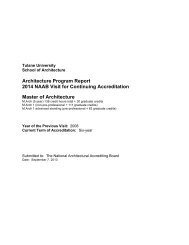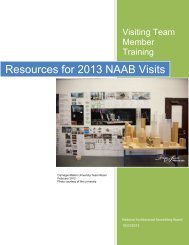Architecture Program Report Tulane University New Orleans ...
Architecture Program Report Tulane University New Orleans ...
Architecture Program Report Tulane University New Orleans ...
You also want an ePaper? Increase the reach of your titles
YUMPU automatically turns print PDFs into web optimized ePapers that Google loves.
Architectural Education<br />
Architectural education in North America and globally is undergoing substantial change<br />
and redefinition. Historically, the profession expected graduates of schools of<br />
architecture to be able to assume the challenging roles of professional practice with<br />
ease. This demand has only increased over the past few decades. Recently graduated<br />
students are expected to also be broadly educated and flexible thinkers with the abilities<br />
to effectively manage complex processes and projects—in addition to the traditional<br />
knowledge gained by university education.<br />
Other conditions affect the scope of architectural education, including:<br />
● The critical changes resulting from the largest natural and man-made<br />
disaster in the nation's history (Hurricane Katrina)<br />
● An increase in the significance of Service Learning opportunities as a<br />
component of architectural education<br />
● The conflict between professional and university perceptions of education<br />
● The role of internship and licensure in architectural education<br />
● The development of new models for the Continuing Education of<br />
architects, and the role of the schools in these programs<br />
● The role of accreditation criteria in curricular development.<br />
● The rising cost of education, as compared to career compensation.<br />
● The historically low teacher to student ratios in architectural programs.<br />
● The pedagogical and resource implications of digital technologies for<br />
curricular development<br />
● The implications of new technologies as an added and ongoing expense.<br />
● An expansion of the numbers and kinds of architectural programs, as well<br />
as increased competition among programs of excellence for high-quality faculty<br />
and students<br />
● The necessary expansion of global learning opportunities through<br />
exchange and other educational programs.<br />
● An historically difficult environment for fundraising, both from the<br />
profession and from external sources.<br />
SWOT Analysis<br />
The National Architectural Accrediting Board (NAAB) reviewed the School of <strong>Architecture</strong><br />
in 1999 and 2002, and another review will occur in 2008. The accreditation process<br />
consists of an Architectural <strong>Program</strong> <strong>Report</strong> (APR) that the School of <strong>Architecture</strong><br />
prepares, followed by an accreditation team site visit comprised of members from the<br />
five collateral organizations governing architectural practice and education in the United<br />
States. These five organizations are: the National Architectural Accrediting Board<br />
(NAAB), the American Institute of Architects (AIA), the American Institute of Architectural<br />
Students (AIAS), the Association of Collegiate Schools of <strong>Architecture</strong> (ACSA), and the<br />
National Council of Architectural Registration Boards (NCARB). Upon completion of the<br />
site visit, the accreditation team prepares a list of conclusions. In <strong>Tulane</strong>'s case, these<br />
findings were spelled out in the Visiting Team <strong>Report</strong>s (VTR), and will be used in part to<br />
address the SWOT Analysis (as noted in specific sections).














